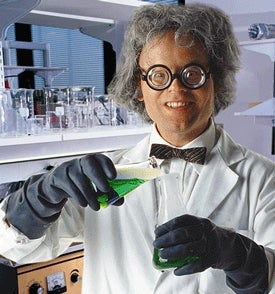CAMBRIDGE, MA–Dead-tissue reanimation, projected in the 1980s to be standard medical practice by 2001, won’t be possible for at least another decade, scientists at the Massachusetts Institute of Technology’s Mad Science Research Center announced Monday.

“They laughed when we said we would rekindle the divine spark of life in flesh grown cold and lifeless,” said MIT mad scientist Dr. Otto Von Verruchtheit, the nation’s leading corpse-reanimation expert, speaking from the castle that houses the MSRC’s state-of-the-art corpse-reanimation laboratory. “Oh, how they laughed! They said we were mad to attempt such an unholy ambition by the century’s end. Fools! Fools, all of them! However, in this case, they were actually right.”
Von Verruchtheit then raised his arms to the heavens, attempting to summon a lightning bolt and thunder crash to punctuate his remarks. After several unsuccessful attempts, he gave up.
Von Verruchtheit’s colleagues in the mad-scientific community admitted that that it may be decades before reanimation technology becomes a reality.
“The truth is, there are certain forms of horrible knowledge that Man was not meant to possess,” said University of Chicago mad scientist Dr. Hans-Klaus Menschesser. “A twisted mind lusting after the unclean power to play God is not enough to bring the dead back to life. Only through strict adherence to the scientific method can these hubristic and unnatural schemes become possible.”

Still, others are more confident. “My plan to form a Modern Adam from the mere dust and clay of newly dead matter is not yet lost,” said Stanford University’s Dr. Hugo Dammerung, who predicted routine cadaver reanimation by 2000 in the October 1989 issue of Mad Scientific American. “True, I was unable to bring Helga, my beloved research assistant, back from the realm of death by the tenth anniversary of her fatal accident, but the problems are merely technical and will doubtless be solved by further diligent research and grave-robbing. And, indeed, why rush? Sweet Helga remains unwithered by the cruel ravages of Time, still as fair and fresh as the day she fell from her horse on the misty moor.”
Dammerung then tenderly embraced the moldering pile of desiccated female remains on the stone dais of Stanford’s Undergraduate Necrolab.
During the demented-tech boom of the ’80s and early ’90s, the mad sciences made great strides, including the development of high-voltage neck bolts and the discovery of a neon-green fluid that produces smoke when poured into beakers. But the past five years have witnessed a significant drop-off in federal funding for university-level mad-science programs.
“Just a few years ago, this field was booming,” National Mad-Science Foundation director Dr. Gustav Blutgeist said. “In 1995, Cal Tech’s mad-science Ph.D. program banished 39 brilliant-but-obsessed young men for practicing on non-living matter. By last year, that number had dropped to just four.”
The situation has been exacerbated by the elimination of hunchback-studies programs at many technical colleges. Since 1990, the number of schools offering a two-year hunchbacking degree has dropped from 492 to 39, leaving many mad scientists without much-needed grotesque lab assistants.
“I have been waiting with my large syringe of glowing blue fluid and a brain in a glass jar since 1994,” said University of Colorado mad scientist Dr. Zunther Kornbluth, speaking from his hidden laboratory high in the Rockies. “I believe I have solved the problem of violent reactions to organ music which so marred my experiments with the rabbits. Now, all I need is one major research grant to fund my raised lightning-attractor table, and I will create life! Life, do you hear me? Life!”







